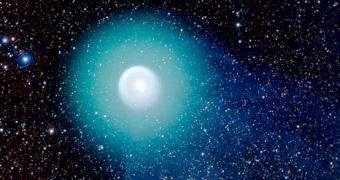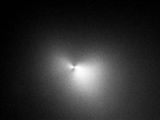Currently, the largest celestial body in the solar system is not the Sun as you would think, but a comet. The outburst of comet Holmes, on 23rd of October, is still troubling scientists in the search to explain what event could have triggered it. The comet is slowly turning into a star of the night sky, due to the large cloud of gas, emanating from its nucleus. Now the Hubble Space Telescope pointed towards the core of the comet, in the hope that the mystery will be finally revealed.
The comet has suddenly become visible on the night sky on the 23rd of October, when it multiplied its brightness by a factor of half of million. Astronomers thought that the large emission of gases from its core was due to the disintegration of a part of the nucleus. The debris emerging from its core scattered all around the comet, at a speed of about 0.5 kilometers per second, and has currently reached a diameter of about 1.4 million kilometers, bigger than the diameter of the Sun, according to astronomers and the University of Hawaii.
NASA has been periodically checked with the Holmes comet, with the help of the Hubble Space Telescope, and released its latest picture yesterday, taken on November 4th with the Wide Field Planetary Camera 2.
The picture indicates a bow-tie shape around the core of the dust cloud, revealing that there is about twice as much dust emerging from the east-west direction, suggesting a probable future breakup of the core. The same evidence can be seen in picture taken from ground based telescopes, revealing an offset of the cloud in relation with the nucleus, indicating that a large piece has already broken off and can be distinguished as moving away from the core.
Though indistinguishable in the past week, the comet has lately sprung a hint of a tail. Usually, comets present two Tails, one of dust, and another of ionized gas due to the action of the solar wind.
The comet is presently moving away from Earth, and is positioned somewhere between the orbits of the planet Mars and Jupiter, in the asteroid belt, about 238 million kilometers away. Even so, the Hubble Space Telescope would still be able to spot features as small as 54 kilometers across, though the resolution of the image would not be fine enough, there are other ways of peeking at the comet's core, and reveal its secret.
The estimated diameter of the nucleus before the outburst was about 3.4 kilometers, based on the brightness of the light reflected from its surface, and the theory regarding the breakup of the nucleus will be put to the test, as soon as the dust cloud clears up, to see how much of the original nucleus is still left.
A small telescope or a pair of binoculars are enough to take peeks at the fuzzy bright comet on the night sky, and if that's not enough to motivate you, remember that this weekend is the peak of the annual Leonid meteor shower.
Certain assumptions claim that the comet might have heated up during its swing around the Sun, releasing volatile gases which built up in the nucleus and caused an explosion months later. This might have sheared a piece of the nucleus, and disintegrated into dust to create a bright cloud of debris. Astronomers observing the event in 1892, believed that the outburst was caused by the collision of the comet with another celestial body.

 14 DAY TRIAL //
14 DAY TRIAL // 
